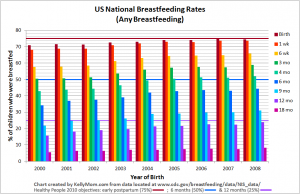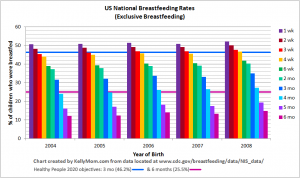Breastfeeding rates in the United States and worldwide
What percentage of moms breastfeed their babies? How long do they breastfeed? These questions have interested me, and prompted me to look for research that has been done. I’m posting the results of my efforts here, for the benefit of anyone else who might be interested.
Various Countries Compared
Global Data Base on Breastfeeding from World Health Organization/UNICEF
State of the World’s Children: Nutrition from World Health Organization/UNICEF. The nutrition tables include breastfeeding data.
Now infants can get
all their vitamin D
from their mothers’ milk;
no drops needed with
our sponsor's
TheraNatal Lactation Complete
by THERALOGIX. Use PRC code “KELLY” for a special discount!
OECD Family database: Child Outcomes: CO1.5 Breastfeeding rates [PDF] from the Organisation for Economic Co-operation and Development (OECD)
World Breastfeeding Trends Initiative (WBTi) from IBFAN Asia
Breastfeeding Statistics, September 15, 2003, compiled by Carol Huotari IBCLC for the LLLI Center for Breastfeeding Information, includes breastfeeding initiation rates and percentages of mothers breastfeeding 4-6 month old babies in many countries around the world.
United States Breastfeeding Rates
US Centers for Disease Control
The US Centers for Disease Control collects statistics on breastfeeding rates in the United States. Following are some useful links to their information:
- CDC: Breastfeeding Data and Statistics– Current!
- Current Data from the CDC National Immunization Survey
- Breastfeeding in the United States: Findings from the National Health and Nutrition Examination Survey, 1999-2006
 Breastfeeding by mothers 15–44 years of age by year of baby’s birth, according to selected characteristics of mother: United States, average annual 1972–74 to 1993–94.
Breastfeeding by mothers 15–44 years of age by year of baby’s birth, according to selected characteristics of mother: United States, average annual 1972–74 to 1993–94.

US National Breastfeeding Rates. This shows the percentage of babies who received any breastmilk at all (at the breast or via alternative methods).

US National Exclusive Breastfeeding Rates. Exclusive breastfeeding, as defined in this CDC survey, means that baby receives nothing but breastmilk (at the breast or via other feeding methods).
Ross Labs
Until relatively recently, ironically enough, the primary source for statistical information on breastfeeding rates for the United States was Ross Labs (Ross Products Division, Abbott Laboratories), one of the major infant formula manufacturers. This used to be essentially the only source for breastfeeding statistics. Ross only collects information for babies up to 12 months old, since that is their primary sales market.
View Ross Labs data & graph (1970-2003): [in this window] [in a different window]
Breastfeeding after 12 months in the United States
Hills-Bonczyk SG, Tromiczak KR, Avery MD, Potter S, Savik K, Duckett LJ. Women’s experiences with breastfeeding longer than 12 months. Birth. 1994 Dec;21(4):206-12.
| This study might be of interest to other mothers who breastfeed for more than a year. This information was taken from the abstract. |
- Greater age, education, and weeks of exclusive breastfeeding were associated with longer duration of breastfeeding.
- 68% of the women who breastfed longer than one year returned to employment before their infant was 1 year old.
- The most frequently chosen reason for long-term breastfeeding was that breastfeeding was a special time for mother and baby that the mother was not ready to give up.
- Nearly half of the women reported breastfeeding their babies on demand.
- At 12 to 15 months, 54% of the babies slept in a crib in a separate room. 37% slept in the same bed with their mother all or part of the night.
- 57% of mothers considered their support group to be lightly or moderately important in influencing their decision to breastfeed beyond a year. 10% considered it to be extremely important.
- The major themes that emerged from women`s comments were the importance of being strong in the face of social unacceptability, development of a close mother-child bond, and the naturalness of breastfeeding beyond 12 months.
Sugarman M, Kendall-Tackett KA. Weaning ages in a sample of American women who practice extended breastfeeding. Clin Pediatr (Phila). 1995 Dec;34(12):642-7.
| This study asked the question: “Do US women who practice attachment-style parenting have weaning ages similar to women in more traditional cultures, or would they succumb to societal pressure to wean at earlier ages?”The 179 women studied were recruited from La Leche League Area Conferences. All had nursed at least one child for six months or more. Weaning ages varied widely, ranging from one month to seven years, four months. The average age of weaning for children was 2.5 years (3 years for youngest children). |
|
||||||||
| Reasons for weaning included: “child-led”; related to a subsequent pregnancy; illness or family circumstances; not being able to diet seriously while nursing.When women who were currently nursing were asked how they would go about weaning, the majority indicated that weaning should be child-led. Mothers also indicated that they would cut down the number of nursing sessions, substitute other forms of love and nurse only when the child wanted to (practicing “don’t offer, don’t refuse”).The results of this study suggest that women who practice extended nursing and child-led weaning are likely to nurse well into early childhood. They are also consistent with the weaning ages found in traditional cultures. | |||||||||
Worldwide Breastfeeding Rates
Australia
Growing Up In Australia: The Longitudinal Study of Australian Children, Annual Report 2006-07
Breastfeeding in Australia, 2001 (9/17/2003), from the Australian Bureau of Statistics, presents data from the 1995 and 2001 National Health Surveys.
The Australian National Health and Medical Research Council (NHMRC) “Dietary Guidelines for Children and Adolescents in Australia incorporating the Infant Feeding Guidelines for Health Workers”, dated 10 April 2003, discusses historical and current breastfeeding rates in Australia (see Part 1. Encourage and Support Breastfeeding)
![]() Towards a national system for monitoring breastfeeding in Australia: recommendations for population indicators, definitions and next steps from the Australian Food and Nutrition Monitoring Unit (2001)
Towards a national system for monitoring breastfeeding in Australia: recommendations for population indicators, definitions and next steps from the Australian Food and Nutrition Monitoring Unit (2001)
A search of Lactnet (site no longer exists) resulted in some 1995 Australian statistics (source: extracted from a report from the Australian Bureau of Statistics “Australian Social Trends 1997”. This includes some “unpublished” breastfeeding data from the major 1995 National Health Survey in Australia.):
|
|
|
| Never breastfed | 12.4 % |
|
|
|
| Breastfed… | 87.6 % |
| Less than one week | 1.9 % |
| Two weeks or more | 77.7 % |
| Two months or more | 68.1 % |
| Six months or more | 47.1 % |
| One year or more | 15.3 % |
| Unknown duration | 2.3 % |
|
|
|
Canada
Health Canada: Breastfeeding Practices in Canada: Overview
Williams PL, Innis SM, Vogel AM. Breastfeeding and weaning practices in Vancouver. Can J Public Health. 1996 Jul-Aug;87(4):231-6.
82.9%…….Percentage of babies breastfed at birth
18.2%…….Percentage of babies breastfed at 9 months
India
Chhabra P, Grover VL, Aggarwal OP, Dubey KK. Breast feeding patterns in an urban resettlement colony of Delhi. Indian J Pediatr. 1998 Nov-Dec;65(6):867-72.
Japan
Breastfeeding statistics from the First Longitudinal Survey of Babies in 21st Century (2001), Vital and Health Statistics Division, Statistics and Information Department, Ministry of Health, Labour and Welfare, Japan.
Malaysia
Johnson A, Ramos GAG, Sarai F. Infant feeding practice and its relationship with nutritional status and socio-cultural factors in infants 0-12 months of age in Taman Sri Nanding, Hulu Langat, Selangor, Malaysia. (data from 1998)
South Africa
A Demographic and Health Survey of 1998 indicated that 10% of children 0 – 3 months were exclusively breastfed and 2% of children 4 to 6 months were exclusively breastfed.
Sweden
![]() Breast-feeding, children born 2000 from the Centre for Epidemiology at the National Board of Health and Welfare, Official Statistics of Sweden (Amning av barn födda 2000, HÄLSA OCH SJUKDOMAR 2002:7). Includes a summary in English, and tables have both Swedish and English text.
Breast-feeding, children born 2000 from the Centre for Epidemiology at the National Board of Health and Welfare, Official Statistics of Sweden (Amning av barn födda 2000, HÄLSA OCH SJUKDOMAR 2002:7). Includes a summary in English, and tables have both Swedish and English text.
United Kingdom
National Infant Feeding Survey from the United Kingdom
UK Breastfeeding Rates from BabyFriendly.org.uk
Other sources of information
Breastfeeding Patterns in the Developing World (1999) from MeasureCommunication.org
Parenting magazine had some information on breastfeeding rates around the world in their April 1997 issue. Their article (p. 34) was entitled “Breastfeeding by the Numbers.” The information below is from this article.
The World Health Organization and UNICEF have recommended for a decade that mothers breastfeed for at least two years. But most US women who nurse stop before their baby is six months old – and many never start at all. How do other countries stack up?
| Country | % of mothers who start | % who continue 6 months or longer |
|
|
||
| Sweden | 98 | 53 |
| Norway | 98 | 50 |
| Poland | 93 | 10 |
| Canada | 80 | 24 |
| Netherlands | 68 | 25 |
| Britain | 63 | 21 |
| United States | 57 | 20 |
|
|
||
| Sources: Baby Milk Action, Cambridge, England; Center for Breastfeeding Information, Schaumburg, IL | ||
